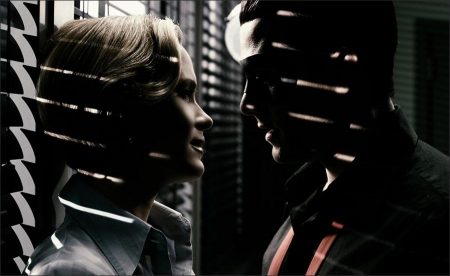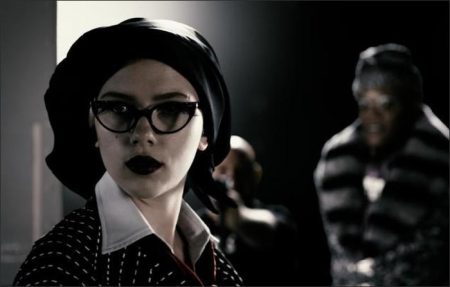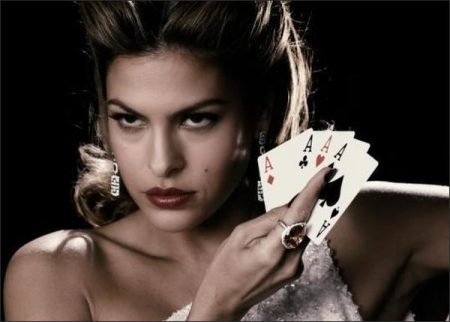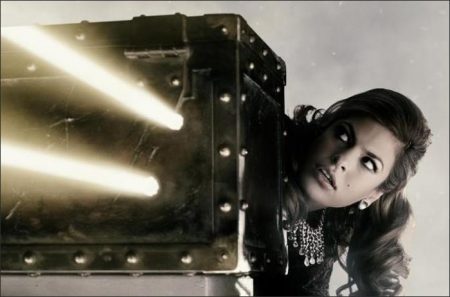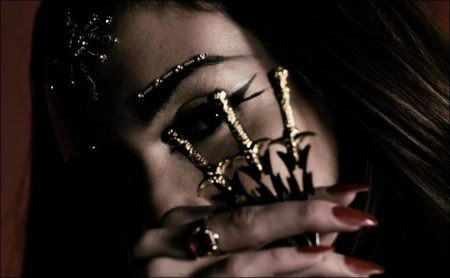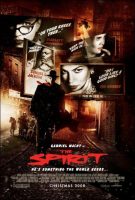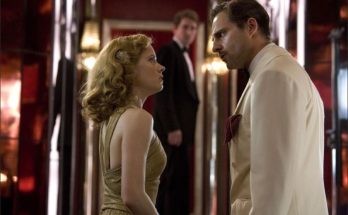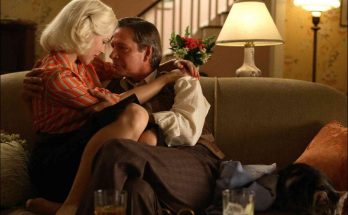Tagline: He’s something the world needs.
Frank Miller, the visionary creator Sin City and 300, takes the comic book movie to dazzling new heights with his solo directorial debut The Spirit. Adapted from the seminal series by the great Will Eisner, The Spirit fuses masterful storytelling with brilliant CGI graphics to sweep us into a stylized world of adventure, danger and romance. Miller set out with a baseline goal of creating a PG-13 film of Eisner’s masterpiece, enabling himself to explore new ways of spinning a tale. In so doing, he reveals another side of Frank Miller, the filmmaker.
The Spirit is the story of Denny Colt, a murdered cop who is mysteriously reborn as the masked crime fighter called the Spirit. Determined to keep his beloved Central City safe, the Spirit pursues Central City’s villains from the shadows and seeks to remove to the worst of them all: the psychotic megalomaniac known as the Octopus. Yet as busy as his ongoing mission keeps him, the dashing crusader always manages to make time for beautiful women, though he never quite knows if they want to seduce, love or kill him. But there is one lady who will never betray him, and to whom he will always be true: Central City, the proud old metropolis where he was born – twice.
The Spirit is a 2008 American neo-noir superhero film, written and directed by Frank Miller and starring Gabriel Macht, Eva Mendes, Sarah Paulson, Dan Lauria, Paz Vega, Jaime King, Scarlett Johansson, and Samuel L. Jackson. The film is based on the newspaper comic strip, The Spirit by Will Eisner, and produced by OddLot and Lionsgate Films.
Released in 2,509 theaters, The Spirit grossed $10.3 million in its opening four days, placing 9th in the box-office ranking for the weekend. The film grossed $19.8 million in the US and $18.6 million internationally for a worldwide total of $38.4 million. Variety estimated that the film’s poor performance at the box office cost Odd Lot Entertainment tens of millions of dollars in losses, but Odd Lot Entertainment’s CEO Gigi Pritzker denied rumors that Miller’s other projects had been canceled.
About the Production
In bringing this comic book classic to the screen, Miller has recruited a dynamic cast of major stars and up-and-comers. As the titular hero, Gabriel Macht turns in a star-making performance that harkens back to the golden era of placeHollywood leading men. He is joined by Samuel L. Jackson as the fiendish Octopus; Scarlett Johansson as the Octopus’ sidekick, the brilliant, frosty Silken Floss; Eva Mendes as seductive jewel thief Sand Saref; Sarah Paulson as the Spirit’s stalwart sweetheart, Dr. Ellen Dolan; Jaime King as Lorelei, a bewitching underwater phantom; Paz Vega as the mad, knife-wielding dancer Plaster of Paris; Dan Lauria as the hard-boiled Commissioner Dolan; Stana Katic as Morgenstern, an enthusiastic young cop; and Louis Lombardi in multiple roles as the Octopus’ cloned brotherhood of henchmen. The film’s behind-the-scenes artisans include acclaimed director of photography Bill Pope, ASC (Spiderman 2 and 3, the Matrix trilogy, Bound) and senior visual effects supervisor Stu Maschwitz (Fantastic Four: Rise of the Silver Surfer, Sin City).
It’s a moonlit night in Central City, and a call comes in to the Spirit (Gabriel Macht). Some sort of shady deal is about to go down at the mudflats near the waterfront, involving an old, sunken cargo ship and the city’s most terrifying criminal, the Octopus (Samuel L. Jackson). The Spirit leaps into action, but the Octopus is only too happy to battle him until both men are several steps beyond punch-drunk. Meanwhile, the Octopus’ ice-cold accomplice, Silken Floss (Scarlett Johansson), is headed back to their underground headquarters with one of two mysterious treasures looted from the bottom of the sea.
As the smoke clears, one cop is dead and another is barely clinging to life. The Spirit should be dead too: he’s been shot, knifed and kicked to kingdom come several times over. And while his steady sweetheart, top surgeon Ellen Dolan (Sarah Paulson) is there to stitch him back together, the Spirit knows he’ll heal up just fine, and fast. What he doesn’t know is why.
However, there’s no time to ponder that riddle. As long as the Octopus is still at large, no one in Central City is safe. What’s more, the Octopus wasn’t the only person at the mudflats. There was a woman there, too, and all signs point to the same unlikely candidate: the alluring international jewel thief Sand Saref (Eva Mendes).
Sand Saref. The name alone can make the Spirit’s heart skip a beat: a man’s first love will do that to him. But that was long ago, back when Sand Saref and Denny Colt were just neighborhood kids. Before a tragedy came between them, and sent them on radically different paths in their lives. Sand had vowed never to return to Central City. Could the woman at the mudflats really have been her? And could the `girl next door’ that Denny knew really have become a woman capable of murder?
As another dead body turns up, the Spirit intensifies his search for his lost love. Meanwhile, the Octopus, Silken and their infinitesimal band of merry, identical henchmen (Louis Lombardi) are also on the hunt for the jewel thief, seeking an exchange of the treasures that brought them to the mudflats in the first place.
Once that exchange happens, the Octopus will be able to realize his master plan to control all of Central City. Only one man, the Spirit, can possibly stop him. But the Octopus knows more about our hero than he knows himself — including not only the cause of his seeming immortality, but the cure for it.
Stages and Screens
The filmmakers’ plan for The Spirit was indeed ambitious: it called for shooting the entire production using green screen technology and state-of-the art CGI programs to create a hybrid of motion picture and comic book. Miller had first been exposed to advanced digital filming techniques when he co-directed Sin City with Robert Rodriguez. “What’s happened with computer technology and with CGI is timed perfectly for someone with my set of skills,” he acknowledges. “I tell stories with pictures. What I love about CGI in film is if I can think it, it can be there. And as much this technology speaks to the future, it also can bring back some values of the past. Not just the comic book values of the strange-looking city and the loud lighting, but also the values of classic noir. I wanted The Spirit to have the starker, scarier look of those old movies.”
Del Prete carefully selected the top-flight crew that would help Miller realize his vision for The Spirit. Says the producer, “We set out to find people who were very much simpatico with the concepts of the comics Frank had written. We wanted people who knew of Eisner and `The Spirit.’ So Frank was surrounded by talented people who really were excited about working with him on this film. Every single team member was somebody who was very special.”
That certainly describes Miller’s key technical collaborators: the renowned director of photography Bill Pope, whose credits include Spiderman 2 and 3, The Matrix trilogy and Bound; and senior visual effects supervisor Stu Maschwitz, the founder of the innovative visual effects house the Orphanage, whose stunning work includes Iron Man, Night and the Museum, Superman Returns and Harry Potter and the Goblet of Fire.
Pope jumped at the chance to join Miller for his first solo directorial outing. As he explains, “Frank Miller calls you up and says, `You want to do a movie?’ Here’s a man who’s a master in another visual medium. You want to see what he does. What do you do if Julian Schnabel calls you up? You say yes.”
Maschwitz also served as the film’s second unit director, and began advising Miller on the film’s visual effects in pre-production. “Frank is abuzz with the energy that you feel in his artwork,” he states. “He’s got a profound vision and it’s amazing to see him work to bring these characters to life that he defines on the page with just a simple pose or gesture.”
The Spirit began production in placeCityAlbuquerque, StateNew Mexico on October 8, 2007 and was the first feature film to be shot at the newly constructed Albuquerque Studios. Stages 7 and 8 were transformed into a huge green screen stage, a black screen stage and a stunt stage that could change from green to black. The ambitious 48-day schedule involved over a hundred actors and stunt players.
For the actors and key technical departments, Miller created notebooks of the original Eisner stories that The Spirit would draw upon. And the writer / director began each day by drawing storyboards that enabled actors and crewmembers alike to visualize the scenes they would be shooting. Comments Del Prete, “Frank made sure that all the people on this film really understood the original art, as well as his style of art. And he did create a hybrid of the two. There wasn’t a day that went by that we didn’t talk about Will.”
Together, Miller, Pope and Maschwitz mapped out an adventurous visual strategy. “We decided to make The Spirit even more stylized, more in line with Frank’s drawings than even Rodriguez did,” Pope explains. “Stu and I were acolytes, in the sense that we understood Frank Miller and his sensibility. Our job was to translate what was in his brain, what was in his drawings, into a technical world. Frank’s not a technician. What he is fantastic with, is finding that moment, that emotional beat at the core of every scene.”
A spirit of creativity and playfulness pervaded the set, on both sides of the camera. For Miller, that attitude was essential for a proper adaptation of Eisner’s work. “Will was always an adventurer in his work,” he explains. “What I wanted to do in this movie was get back in touch with that sense of experimentation that he brought to `The Spirit,’ that defined `The Spirit.’ The entire cast and crew – we were all willing to try things.”
Sam Jackson agrees, noting that Miller was receptive to the actors’ ideas about everything from line readings to facial hair. Once placeCityJackson saw the completed costumes and the minimal or nonexistent sets, he realized he could go even farther with the larger-than-life character he was creating. “We realized we could kick the Octopus into another space with wigs and eye makeup and all kinds of elaborate things on my face. We had a great time thinking about the character, and I think that helped us create a really fun, memorable villain.”
Miller was thrilled with his cast. “I’ve got a history of sitting at a drawing board, coming up with stories and pictures and making up my own actors. So probably the biggest surprise is that I love actors, and love working with them. Everyone in the cast was superb. Really, I think the actor creates the character. The director just helps them along.”
The Spirit called for vibrant and smartly delineated wardrobe design for all the characters. It was a challenge that costume designer Michael Dennison embraced as he devised stylized garments that would reflect personality, history and changes in mood. For placeCityJackson’s Octopus, he created a series of outfits to complement the fiend’s adoration of iconic evil, from the archetypal Western bad guy to a murderous samurai and even a Nazi. And there were gorgeous and varied garments for the film’s splendid women: gowns, suits, dresses and more that nodded to the feminine silhouettes of the mid-20th Century while maintaining a modern feel.
In contrast, the Spirit’s wardrobe called for simple, statement-making pieces. Dennison made a few subtle alterations to the Spirit’s attire to bring the character into the present day. “The original Spirit wore a suit,” Dennison notes. “We pared his costume down to just a shirt, tie, trousers, belt, sneakers, plus an incredible trench coat and a fedora. The trench coat was lovingly referred to as the cape, because it floated, it flew, it concealed, it wrapped. The scarlet tie was part of Frank’s vision. It’s a graphic image that becomes the character’s signature.”
Some of the boldest innovations in The Spirit involved the film’s extended underwater sequences, including scenes of Mendes’ and Jackson’s characters pursuing their loot beneath the mudflats of Central City. The filmmakers wanted to achieve an effect possible only in comics, with Mendes’ Sand Saref looking as breathtaking underwater as she does on land. To achieve this, Pope filmed the scenes using specially designed lighting and a Phantom camera, a high-speed digital model generally reserved for scientific applications. Mendes was suspended in a harness, and not a drop of water was required. Says Del Prete, “We got what we asked for: totally believably underwater. And Eva looks like a goddess — her makeup and hair absolutely perfect — because she’s not actually underwater. Just like in the comics!”
The Spirit was conceived as a contemporary noir, with color playing a highly targeted, powerful role. The color palette was established in production, via lighting, costume design, art direction and other cues, and carried through in post-production. “We never felt that the film should be pure black and white; we wanted to see skin tone and flesh,” says Pope. “So we worked our way to just an understanding of what the thematic colors were. For example, when Frank wrote the scene of Young Spirit and Young Sand on the porch, I knew that they were opening a locket. The locket could be gold, the memory could be a golden memory. And Sand is materialistic. So gold became her color.”
Once production wrapped, the center of activity moved to the Orphanage’s Northern California headquarters, where Maschwitz supervised a visual effects team of some 200 people at 10 facilities around the world, including Australia, Los Angeles and Canada. For Maschwitz and his colleagues, the task at hand was nearly the reverse of standard visual effects work. “Most often, our job is to take a shot that is complete except for one small element, and insert that element into the shot,” Maschwitz explains. “With The Spirit, we have one small very important element, which is the performance, and we’re filling in the entire background.”
Meanwhile, in Los Angeles, editor Greg Nussbaum joined the post-production team. Nussbaum came to the film after being recommended by Stu Maschwitz, with whom he’d worked on commercials and music videos. “The difficulty with this type of film is that your editor only has actors on green screen to cut. They really have to have a lot of imagination to understand what they are doing. Deborah wanted someone who would really understand Frank’s style like the rest of the team. Greg had been an editor for the pre-viz period of The Spirit and I knew he was very talented and would be a good match,” recalls Stu Maschwitz. Del Prete gave the first few weeks’ footage to Nussbaum as a test to see what he would make of it. She and Miller loved the results and brought him aboard.
Post is one of the most important parts of the process – especially in a film like The Spirit and while they had Maschwitz and The Orphanage making sure every visual was perfect, Miller and Del Prete also had to make sure the sound and music was up to the standards of the picture. They spent a lot of time listening to scores and meeting with composers. Producer Del Prete recalls, “We were very fortunate to have a wealth of choices.
After seeing samples of the footage literally everyone we wanted to meet with was very excited about taking on the film. The hardest part was having to say no to so many really great music makers. After consideration, the highly accomplished multiple Academy Award nominee David Newman (Anastasia, Ice Age, The Phantom) joined the team. Frank wanted elements of the `40s jazz sound married with iconic heroic music and even a touch of the spaghetti western. David was able to bring it all home for us.”
It was in post-production that Maschwitz worked with Miller to bring to life a critical character in The Spirit: Central City, the Spirit’s greatest love. Eisner based the city on his native Manhattan, which is also Miller’s longtime home. Says Miller, “Stu and his company created the Central City of my dreams, which is Manhattan from around Jane Street up to Houston. That’s because the Spirit is more a neighborhood character than a protector of an entire city. Stu and his team created an evocation of different eras of New York. It is kind like Pompeii on top of Pompeii, on top of Pompeii. It goes as modern as you want and as far back as you want.”
Adds Maschwitz, “Central City is the New York that Frank sees when he walks around Manhattan. You pick and choose bits and pieces of a real city so that it has that kind of tangible reality and messiness that a real urban environment does, but then you selectively dis-include the parts of it that don’t fit in with Frank’s and Eisner’s world. What you wind up with is Central City. And the movie really is a love letter to this environment.”
It’s also a fond, respectful tip of the hat to Will Eisner, the man who helped create the comics. “I threw myself into this,” says Miller about the huge undertaking to bring The Spirit to the screen. “If it was going to be The Spirit it was going to be as good as I could possibly make it. I hope Will doesn’t rise from the grave and strangle me when he sees it.”
Actress Jaime King feels Miller has little cause for worry. “What Will Eisner did with `The Spirit’ was very revolutionary; there was really nothing like it at the time. That’s how I feel about what Frank has done with this film.”
Continue Reading and View the Theatrical Trailer
The Spirit (2008)
Directed by: Frank Miller
Starring: Gabriel Macht, Samuel L. Jackson, Scarlett Johansson, Eva Mendes, Sarah Paulson, Paz Vega, Jamie King, Dan Lauria, Stana Katic, Seychelle Gabriel, Frank Miller, Michael Milhoan
Screenplay by: Frank Miller
Cinematography by: Bill Pope
Film Editing by: Gregory Nussbaum
Costume Design by: Michael Dennison, Mark Zunino
Set Decoration by: Gabrielle Petrissans
Art Direction by: Rosario Provenza
Music by: David Newman
MPAA Rating: PG-13 for intense sequences of stylized violence and action, some sexual content and brief nudity.
Distributed by: Lionsgate Films
Release Date: December 25, 2008
Visits: 58
